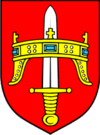Kistanje
Kistanje (Croatian: Kistanje, Serbian Cyrillic: Кистање) is a village and municipality in Šibenik-Knin County, Croatia.
Kistanje | |
|---|---|
| Kistanje Municipality Općina Kistanje | |
 | |
 Kistanje Location of Kistanje in Croatia | |
| Coordinates: 43°59′N 15°58′E | |
| Country | |
| Region | Adriatic Croatia |
| County | Šibenik-Knin County |
| Municipality | Kistanje |
| Government | |
| • Mayor | Goran Reljić (SDSS) |
| Area | |
| • Total | 244.43 km2 (94.37 sq mi) |
| Population (2011)[3] | |
| • Total | 3,481 |
| Time zone | UTC+1 (CET) |
| • Summer (DST) | UTC+2 (CEST) |
| Postal code | 22305 |
| Area code(s) | 022 |
Geography
Kistanje is located in the microregion of Bukovica, in Zagora. Kistanje is 28 kilometres (17 mi) from county seat Šibenik, 20 kilometres (12 mi) from Knin and 18 kilometres (11 mi) from Skradin. The Adriatic Sea is 25 kilometres (16 mi) to the south-west. The climate is Mediterranean, with an average of 27 °C in the summer and 8 °C in the winter.
History
Kistanje was first mentioned as Latin: Kyztane in 1408.[4][5] It originated close to the remains of a Roman camp Burnum and medieval church. During the Middle Ages it was part of Luka parish and it belonged to Šubić noble family. In 1537 an Orthodox church dedicated to St. Nicholas was built.[6] Kistanje was a trade center of this part of Bukovica. After the Kuridža rebellion in 1704, the village was renamed to Kvartir; in the 19th century it was again known as Kistanje. In 1888, the second Orthodox church, dedicated to Sts Cyril and Methodius was built. In 1894 the Catholic Church of Our Lady of Health was built.[7] In the 19th and the first part of the 20th century, Kistanje was the centre of a municipality that was abolished in the 1960s. The municipality and its territory were joined to the municipality of Knin.
During the Croatian War of Independence, local Serb rebels held the village until its capture by the Croatian Army during Operation Storm on 5 August 1995. During this period, the Church of Our Lady of Health was devastated, and most of the non-Serb population fled. The village remained under the control of Republic of Serbian Krajina until 1995, when it suffered heavy damage in battle, and some of the local civilians were killed (see Varivode massacre), while others fled.
In 1997, Kistanje became a municipality within the Šibenik-Knin County. In 1997, around 1,000 Croats from Janjevo in Kosovo were settled in the village.[8] In 2003 the second Catholic church, the Church of Saint Nicholas was dedicated.[7]
Population
According to the 2011 census,[3] the municipality of Kistanje had 3,481 inhabitants, who lived in 14 villages:
- Biovičino Selo – population 223
- Đevrske – population 293
- Gošić – population 46
- Ivoševci – population 360
- Kakanj – population 49
- Kistanje – population 1,909
- Kolašac – population 50
- Krnjeuve – population 74
- Modrino Selo – population 47
- Nunić – population 110
- Parčić – population 22
- Smrdelje – population 111
- Varivode – population 124
- Zečevo – population 63
In the 2011 census, there were 3,481 inhabitants of Kistanje municipality, 62.22% Serbs and 36.83% Croats.[9]
Politics
The municipality council has 14 seats, out of which 10 are Independent Democratic Serb Party (SDSS), 3 are Croatian Democratic Union (HDZ), and 1 is Croatian Social Liberal Party (HSLS).[10] The mayor of Kistanje, since 2012, is Goran Reljić (SDSS).
Notable people
Prominent individuals that were born or that have lived either in Kistanje or the surrounding villages include:
- Vuk Mandušić
- Petar Jagodić Kuridža
- Vladimir Ardalić
- Mirko Korolija
- Simo Dubajić[11]
- Predrag Šarić
Gallery
- Orthodox church
- Orthodox church in Bezbradice
- Railway station
See also
| Wikimedia Commons has media related to Kistanje. |
- Burnum
- Krka Monastery, Serbian Orthodox monastery dedicated to the Archangel Michael located 2.5 km from Kistanje near the Krka river.
- Krka Manojlovac Waterfall[12]
References
- Government of Croatia (October 2013). "Peto izvješće Republike Hrvatske o primjeni Europske povelje o regionalnim ili manjinskim jezicima" (PDF) (in Croatian). Council of Europe. p. 36. Retrieved 30 November 2016.
- "Općine na područjima posebne državne skrbi Republike Hrvatske" (PDF). Croatian Chamber of Economy. Retrieved 15 April 2020.
- "Population by Age and Sex, by Settlements, 2011 Census: Kistanje". Census of Population, Households and Dwellings 2011. Zagreb: Croatian Bureau of Statistics. December 2012.
- "Šesto godina imena Kistanje". Slobodna Dalmacija (in Croatian). 12 October 2008. Retrieved 29 August 2014.
- "600 godina Kistanja..." (in Croatian). Retrieved 9 April 2015.
- "Kistanje". Eparhija-dalmatinska.hr. Retrieved 2014-01-28.
- "Kistanje". zadarskanadbiskupija.hr. Archived from the original on 2016-02-15. Retrieved 2014-01-28.
- "Croatia Resettling Its People In Houses Seized From Serbs". nytimes.com. 14 May 1997. Retrieved 17 February 2018.
- "Census 2011" (PDF). Državni zavod za statistiku. Retrieved 9 January 2015.
- "Sastav vijeća". kistanje.hr (in Croatian). Retrieved 27 September 2015.
- "Nekažnjeni genocid". hkv.hr. 16 July 2014. Retrieved 2016-12-25.
- "Manojlovački slap". npkrka.hr (in Croatian). 2011. Archived from the original on 2014-02-01. Retrieved 17 February 2018.
External links
- "Official municipality website" (in Croatian).
- "Moje Kistanje".
